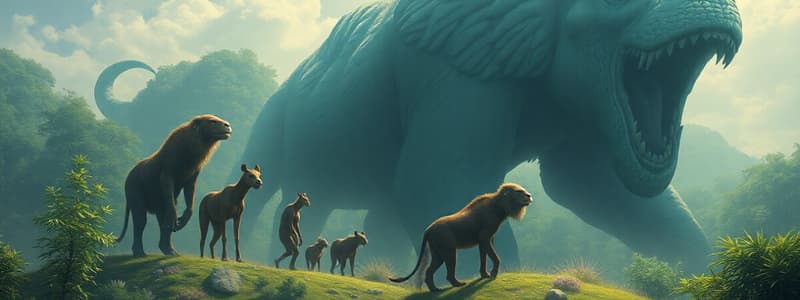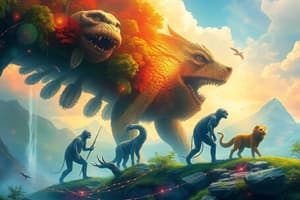Podcast
Questions and Answers
What is the primary application of radio waves?
What is the primary application of radio waves?
- Cooking food
- Communication (correct)
- Medical imaging
- Weather forecasting
Who was involved in the discovery of microwaves?
Who was involved in the discovery of microwaves?
- Heinrich Hertz
- James Clark Maxwell (correct)
- Albert Einstein
- Nikola Tesla
Which of the following is NOT a common application of radio waves?
Which of the following is NOT a common application of radio waves?
- Bluetooth
- Weather forecasting
- MRI (correct)
- GPS
What is the main use of microwaves in the context of weather forecasting?
What is the main use of microwaves in the context of weather forecasting?
Which electromagnetic radiation type has the longest wavelength?
Which electromagnetic radiation type has the longest wavelength?
What significant application is associated with microwaves aside from cooking?
What significant application is associated with microwaves aside from cooking?
In what year was radio waves first discovered?
In what year was radio waves first discovered?
Which of the following scientists is NOT associated with the study of electromagnetic radiation?
Which of the following scientists is NOT associated with the study of electromagnetic radiation?
What provides a competitive advantage for long-necked giraffes?
What provides a competitive advantage for long-necked giraffes?
How does overpopulation impact competition among organisms?
How does overpopulation impact competition among organisms?
What is a key factor that leads to the survival of certain traits in a population?
What is a key factor that leads to the survival of certain traits in a population?
What does the term 'intraspecific competition' refer to?
What does the term 'intraspecific competition' refer to?
What happens to slower cheetahs in the context of natural selection?
What happens to slower cheetahs in the context of natural selection?
What best defines an adaptive trait?
What best defines an adaptive trait?
How does evolution generally occur in a population over time?
How does evolution generally occur in a population over time?
What is the outcome for individuals with the least beneficial traits in a competitive environment?
What is the outcome for individuals with the least beneficial traits in a competitive environment?
What is the significance of predator-prey relationships in evolutionary biology?
What is the significance of predator-prey relationships in evolutionary biology?
What are homologous structures?
What are homologous structures?
According to evolutionary theory, where did Homo sapiens first develop?
According to evolutionary theory, where did Homo sapiens first develop?
What does the argument regarding H. erectus suggest about human evolution?
What does the argument regarding H. erectus suggest about human evolution?
Which of the following is an example of homologous structures?
Which of the following is an example of homologous structures?
What is the primary source of electromagnetic waves listed in the content?
What is the primary source of electromagnetic waves listed in the content?
What leads to the formation of new species?
What leads to the formation of new species?
What are electromagnetic waves primarily formed by?
What are electromagnetic waves primarily formed by?
Which statement is true regarding vestigial structures?
Which statement is true regarding vestigial structures?
Which of the following describes the process of gene flow?
Which of the following describes the process of gene flow?
What characterizes the electromagnetic spectrum?
What characterizes the electromagnetic spectrum?
Which example illustrates analogous structures?
Which example illustrates analogous structures?
What is indicated by the notion that modern humans are of African descent?
What is indicated by the notion that modern humans are of African descent?
Why are sources of electromagnetic waves significant in understanding their nature?
Why are sources of electromagnetic waves significant in understanding their nature?
What is a consequence of a population migrating to a new habitat?
What is a consequence of a population migrating to a new habitat?
What characterizes convergent evolution?
What characterizes convergent evolution?
What is the shortest wavelength and highest energy form of electromagnetic radiation?
What is the shortest wavelength and highest energy form of electromagnetic radiation?
What determines the frequency of a wave?
What determines the frequency of a wave?
Who developed equations that suggest waves in the electromagnetic field travel close to the speed of light?
Who developed equations that suggest waves in the electromagnetic field travel close to the speed of light?
Which part of a wave represents the lowest point?
Which part of a wave represents the lowest point?
What is the definition of amplitude in the context of wave physics?
What is the definition of amplitude in the context of wave physics?
In electromagnetic waves, the term 'wavelength' refers to what?
In electromagnetic waves, the term 'wavelength' refers to what?
Which of the following uses gamma rays for practical applications?
Which of the following uses gamma rays for practical applications?
Which option correctly describes frequency?
Which option correctly describes frequency?
Which electromagnetic wave has the longest wavelength?
Which electromagnetic wave has the longest wavelength?
What happens to the energy of an electromagnetic wave as its frequency increases?
What happens to the energy of an electromagnetic wave as its frequency increases?
In the visible light spectrum, which color has the highest frequency?
In the visible light spectrum, which color has the highest frequency?
In the wave equation $v = fλ$, what does 'f' represent?
In the wave equation $v = fλ$, what does 'f' represent?
If the wavelength of an electromagnetic wave is 20 m, how is its frequency determined?
If the wavelength of an electromagnetic wave is 20 m, how is its frequency determined?
Which electromagnetic wave has the highest frequency?
Which electromagnetic wave has the highest frequency?
What unit is frequency measured in?
What unit is frequency measured in?
Which statement about the relationship between wavelength and frequency is true?
Which statement about the relationship between wavelength and frequency is true?
Flashcards
Natural Selection
Natural Selection
The process where organisms with advantageous traits are more likely to survive and reproduce, passing on those traits to their offspring.
Intraspecific Competition
Intraspecific Competition
Competition between individuals of the same species for resources like food, shelter, and mates.
Variation in Traits
Variation in Traits
Differences in inherited traits among individuals of a species, such as variations in speed, strength, or camouflage.
Evolution
Evolution
Signup and view all the flashcards
Adaptation
Adaptation
Signup and view all the flashcards
Interspecific Competition
Interspecific Competition
Signup and view all the flashcards
Overpopulation
Overpopulation
Signup and view all the flashcards
Beneficial Traits
Beneficial Traits
Signup and view all the flashcards
Convergent Evolution
Convergent Evolution
Signup and view all the flashcards
Homologous Structures
Homologous Structures
Signup and view all the flashcards
Analogous Structures
Analogous Structures
Signup and view all the flashcards
Vestigial Structures
Vestigial Structures
Signup and view all the flashcards
Speciation
Speciation
Signup and view all the flashcards
Gene Flow
Gene Flow
Signup and view all the flashcards
Reproductive Isolation
Reproductive Isolation
Signup and view all the flashcards
Population
Population
Signup and view all the flashcards
Common Ancestor of Humans, Gorillas, and Chimpanzees
Common Ancestor of Humans, Gorillas, and Chimpanzees
Signup and view all the flashcards
African Origin of Modern Humans
African Origin of Modern Humans
Signup and view all the flashcards
Direct Evolution of Homo sapiens from Homo erectus
Direct Evolution of Homo sapiens from Homo erectus
Signup and view all the flashcards
Multiregional Hypothesis of Human Evolution
Multiregional Hypothesis of Human Evolution
Signup and view all the flashcards
Electromagnetic Waves
Electromagnetic Waves
Signup and view all the flashcards
Electromagnetic Spectrum
Electromagnetic Spectrum
Signup and view all the flashcards
Sun as a Source of Electromagnetic Waves
Sun as a Source of Electromagnetic Waves
Signup and view all the flashcards
Wave Equation
Wave Equation
Signup and view all the flashcards
Energy of Electromagnetic Waves
Energy of Electromagnetic Waves
Signup and view all the flashcards
Frequency
Frequency
Signup and view all the flashcards
Wavelength
Wavelength
Signup and view all the flashcards
Speed of Electromagnetic Waves
Speed of Electromagnetic Waves
Signup and view all the flashcards
Visible Light Spectrum
Visible Light Spectrum
Signup and view all the flashcards
Radio Waves
Radio Waves
Signup and view all the flashcards
Microwaves
Microwaves
Signup and view all the flashcards
Radio Detection and Ranging (RADAR)
Radio Detection and Ranging (RADAR)
Signup and view all the flashcards
Radio Communication
Radio Communication
Signup and view all the flashcards
Radio waves in everyday life
Radio waves in everyday life
Signup and view all the flashcards
Microwave ovens
Microwave ovens
Signup and view all the flashcards
Microwave Communication
Microwave Communication
Signup and view all the flashcards
What are gamma rays?
What are gamma rays?
Signup and view all the flashcards
How did Maxwell's equations relate to light?
How did Maxwell's equations relate to light?
Signup and view all the flashcards
What is wavelength?
What is wavelength?
Signup and view all the flashcards
What is amplitude?
What is amplitude?
Signup and view all the flashcards
What is a crest?
What is a crest?
Signup and view all the flashcards
What is a trough?
What is a trough?
Signup and view all the flashcards
What is frequency?
What is frequency?
Signup and view all the flashcards
What is the relationship between frequency and wavelength?
What is the relationship between frequency and wavelength?
Signup and view all the flashcards
Study Notes
Q3 Written Quiz Review Material
- Pointers: The quiz will include multiple-choice questions on biodiversity, evolution, and electromagnetic waves. It will also have modified true or false questions on the electromagnetic spectrum, and problem-solving questions on wave equations.
Evolution and Natural Selection
- Evolution: A change in the genetic composition of a population of organisms over time.
- Natural Selection: The process by which organisms that are better adapted to their environment are more likely to survive and reproduce, passing on their advantageous traits to their offspring.
The Concept of Evolution
- Change: Altering the genetic makeup of organisms, leading to new traits and variations.
- Population: Evolution occurs within a population, not individuals.
- Over Time: Evolution is a gradual process occurring over long periods, resulting in the diversity of life forms.
Theories of Evolution
-
Lamarck's Theory of Use and Disuse: Traits acquired or lost during an organism's lifetime due to use or disuse can be passed on to offspring. (Also known as the Theory of Acquired Characteristics). This was a superseded theory of evolution.
-
Example of Lamarck's Theory: Giraffes stretching their necks over their lifetimes to reach higher leaves would result in an adaptation for longer necks in their offspring that could pass this trait on to future generations.
Darwin's Theory of Natural Selection
- Natural Selection: The process where organisms better adapted to their environment are more likely to survive. This leads to evolution.
- Darwin's Beliefs: Darwin believed that the needs of organisms have nothing to do with the way they evolve, and changes during an organism's life do not affect how the species evolves.
What Did Darwin Believe?
- Variation: Organisms within a population have variations, some advantageous and some less advantageous.
- Struggle for Existence: Populations tend to produce more offspring than the environment can support. This leads to competition for resources.
- Greater Fitness: Individuals with advantageous traits have a higher chance of surviving and reproducing.
- Long-Neck Trait Increases: Giraffes with longer necks have a competitive advantage in reaching higher leaves. Over generations, the proportion of long-necked giraffes increases.
Mechanisms of Natural Selection
- Overpopulation: The number of offspring often exceeds the available resources in the environment.
- Struggle for Existence: Competition for resources (food, water, shelter) occurs between members of the same species (intraspecific) and different species (interspecific).
- Presence and Transmission of Variation: Individuals within a species display variations due to genetic traits.
- Survival of the Fittest: Individuals with advantageous traits are more likely to survive and pass on those traits through reproduction.
The Great Migration
- Description: About 1.5 million wildebeests, along with half a million zebras and gazelles, migrate in search of greener pastures and water.
Variations in Cheetahs
- Faster Cheetahs Survive: Faster cheetahs have a greater chance of surviving, obtaining food, and reproducing. Slower ones are less likely to survive.
- Generational Increase: Over generations, the cheetah population will gradually consist of faster members.
Mechanisms of Speciation
- Gene Flow: The movement of genes between generations.
- Migration: Population shifts to a new habitat causing gene flow.
- Isolation: Separation of one species into two or more groups prevents interbreeding, thus promoting gene flow.
Allopatric Speciation
- Geographic Isolation: A physical barrier, such as a mountain or river, separates a species into groups, preventing interbreeding.
- Evolutionary Differences: Isolated populations begin to evolve separately, leading to potentially different species.
Sympatric Speciation
- Reproductive Isolation: Certain characteristics or behaviors prevent breeding between populations.
- Allele Frequency Changes: Differences in allele frequencies accumulate, causing the two populations to become distinct.
Evolutionary Patterns
- Divergent Evolution: A single species diversifies into multiple species with different traits due to adaptation to varying environments.
- Convergent Evolution: Unrelated species evolve similar traits to adapt to similar environments.
- Extinction: The loss of an entire species due to various factors including pressure posed by their environment.
Adaptive Radiation
- Rapid Species Increase: Closely related species adapting to vacant niches in an environment leading to a rapid increase in species with new traits/characteristics to fill empty ecological niches.
Coevolution
- Predator-Prey Relationships: Species mutually affect each other’s evolutionary development.
Evolution of Man
- Descent of Man: Humans, gorillas, and chimpanzees have shared ancestry, according to Charles Darwin's theory.
Out of Africa Theory
- African Origin: Modern humans originated in Africa and migrated globally.
- Replacement of other lineages: Modern humans replaced other hominid species.
Multiregional Hypothesis
- Simultaneous Evolution: Human species evolved independently, simultaneously in different regions of the world.
Electromagnetic Waves and Wave Equation
- Electromagnetic Waves: Vibration of particles create electromagnetic waves through space.
- Electromagnetic Spectrum: The spectrum covers different wavelengths and frequencies of electromagnetic radiation.
- Wave Equation: It relates speed, wavelength, and frequency of waves.
Parts of the Wave
- Wavelength: The distance from one wave crest to next.
- Amplitude: The height of a wave.
Studying That Suits You
Use AI to generate personalized quizzes and flashcards to suit your learning preferences.




